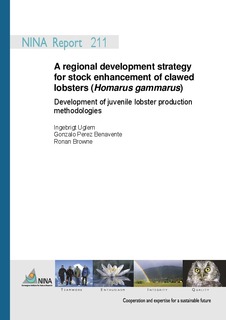A regional development strategy for stock enhancement of clawed lobsters (Homarus gammarus) - Development of juvenile lobster production methodologies
Research report

Åpne
Permanent lenke
http://hdl.handle.net/11250/2440946Utgivelsesdato
2006Metadata
Vis full innførselSamlinger
- NINA Rapport/NINA Report [2341]
- Publikasjoner fra CRIStin - NINA [2364]
Sammendrag
Uglem, I., Perez Benavente, G. and Browne R. A regional development strategy for stock enhancement of clawed lobsters (Homarus gammarus); development of juvenile lobster produc-tion methodologies. NINA Report 211, 39 pp.
European lobsters (Homarus gammarus) are a highly prized and gastronomically appreciated marine organism. As a result of intense fishing pressure lobster landings have declined considerably in many European regions. This decrease has been particularly dramatic in the southern and northern areas of Europe. Releases of artificially raised lobster juveniles have been shown to have the potential to contribute to re-establishment or enhancement of depleted lobster stocks. However, one of the key problems for successful stock enhancement has been the lack of cost effective methodologies for producing juveniles.
After the planktonic stage of their life cycle, the total length of the European lobster ranges from 1.5 to 2 cm. These small early benthic stage animals are extremely vulnerable to predation if released directly into the sea. For this reason it is thought important to rear the lobsters to a length of at least 4 to 5 cm before they are released into the wild in an effort to increase their chances of survival. The purpose of this project was to develop and improve existing methodologies used to produce viable lobster juveniles that are fit for release into the wild.
This project was a part of the AquaReg programme within the framework of the Community initiative programme INTERREG IIIC and it began in 2004. The methodologies used both in the hatchery setting and field were based on rearing the juveniles from metamorphosis until a suitable size for release either in individual compartments suspended from mussel rafts (sea cages or baskets) or communally in natural seawater. Both of these culture techniques involved the postlarval lobsters feeding on naturally occurring plankton and epibiotic fouling organisms. The results demonstrate that survival to a size suitable for release is high when rearing lobsters in suspended baskets (oyster cages). The lobsters also grew well both in sea cage based culture and in communal rearing, despite the fact that lobsters cultured in submerged cages in the open sea were not fed artificial feed during the course of the study.
The methodologies developed represents a cost-effective way of producing lobster juveniles for re-establishment or enhancement efforts, since labour expense, constructions and feeding costs are minimized and the production efficiency is high.